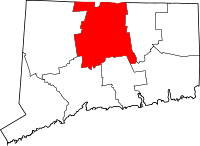New Britain, Connecticut
| New Britain, Connecticut | |||
|---|---|---|---|
| — City — | |||
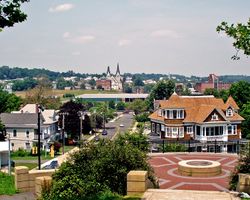 |
|||
|
|||
| Nickname(s): Hardware City, Hard Hittin New Britain | |||
|
|
|||
| Coordinates: | |||
| Country | United States | ||
| State | Connecticut | ||
| Region | Central Connecticut | ||
| Incorporated (town) | 1850 | ||
| Incorporated (city) | 1870 | ||
| Consolidated | 1905 | ||
| Government | |||
| - Type | Mayor-council | ||
| - Mayor | Timothy T. Stewart | ||
| Area | |||
| - Total | 13.4 sq mi (34.7 km2) | ||
| - Land | 13.3 sq mi (34.4 km2) | ||
| - Water | 0.1 sq mi (0.2 km2) | ||
| Elevation | 167 ft (51 m) | ||
| Population (2005)[1] | |||
| - Total | 71,254 | ||
| - Density | 5,358.7/sq mi (2,069/km2) | ||
| Time zone | EST (UTC-5) | ||
| - Summer (DST) | EDT (UTC-4) | ||
| ZIP code | 06050, 06051, 06052, 06053 | ||
| Area code(s) | 860 | ||
| FIPS code | 09-50370 | ||
| GNIS feature ID | 0209217 | ||
| Website | http://www.newbritainct.gov/ | ||
New Britain is a city in Hartford County, Connecticut, United States. It is located approximately 9 miles (14 km) southwest of Hartford. According to 2006 Census Bureau estimates, the population of the city is 71,254.[1]
The city's official nickname is the "Hardware City" because of its history as a manufacturing center and as the headquarters of Stanley Works. Because of its large Polish population, the city is playfully referred to as "New Britski".
Contents |
History
New Britain was settled in 1687 and then was incorporated as a new parish under the name New Britain Society in 1754. Chartered in 1850 as a township and in 1871 as a city, New Britain was separated from the nearby town of Berlin, Connecticut. A consolidation charter was adopted in 1905.
During the early part of the 20th century, New Britain was known as the "Hardware Capital of the World", as well as "Hardware City". Major manufacturers, such as The Stanley Works, Corbin Locks and North & Judd, were headquartered in the city.
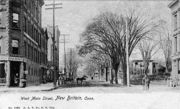
In 1843 Frederick Trent Stanley established Stanley's Bolt Manufactory in New Britain to make door bolts and other wrought-iron hardware. In 1857 his cousin Henry Stanley founded The Stanley Rule and Level Company in the city. Planes invented by Leonard Bailey and manufactured by the Stanley Rule and Level Company, known as "Stanley/Bailey" planes, were prized by woodworkers of the late 19th and early 20th centuries and remain popular among wood craftsmen today. The two companies merged in 1920, and the Stanley Rule and Level Company became the Hand Tools Division of Stanley Works.
The wire coat hanger was invented in 1869 by O. A. North of New Britain, Connecticut.
In 1895 the basketball technique of dribbling was developed at the New Britain YMCA. 1954 saw the development of racquetball, also at the YMCA.[2]
Geography and topography
According to the United States Census Bureau, the city has a total area of 13.4 square miles (34.7 km²), of which, 13.3 square miles (34.6 km²) of it is land and 0.1 square miles (0.2 km²) of it (0.52%) is water.
New Britain's terrain is mostly made up of soft, rolling hills and young Connecticut forest. The many parks are populated with trees, and in small, undeveloped areas, there is also brushy woods. New Britain's streets also have many trees lining the sides of the roads. Many front yards in the northern half of the city have at least one tree. One or two streams flow through New Britain, undisturbed by the development.
Demographics
| Historical population of New Britain[3] |
|
| 1850 | 3,029 |
| 1860 | 5,212 |
| 1870 | 9,480 |
| 1880 | 13,979 |
| 1890 | 19,007 |
| 1900 | 28,202 |
| 1910 | 43,916 |
| 1920 | 59,316 |
| 1930 | 68,128 |
| 1940 | 68,685 |
| 1950 | 73,726 |
| 1960 | 82,201 |
| 1970 | 83,441 |
| 1980 | 73,840 |
| 1990 | 75,491 |
| 2000 | 71,538 |
| 2002 | 71,589 (est.)[4] |
In 1900, 25,998 people lived in New Britain, Connecticut; in 1910, 43,916; in 1915, 52,203; in 1920, 59,316; and in 1940, 68,685.
As of the census[5] of 2000, there were 71,538 people, 28,558 households, and 16,934 families residing in the city. The population density was 5,364.0 people per square mile (2,070.5/km²). There were 31,164 housing units at an average density of 2,336.7/sq mi (902.0/km²). The racial makeup of the city was 69.38% White, 10.89% African American, 0.37% Native American, 2.36% Asian, 0.06% Pacific Islander, 13.12% from other races, and 3.81% from two or more races. 26.75% of the population were Hispanic or Latino of any race.
There were 28,558 households out of which 28.3% had children under the age of 18 living with them, 36.6% were married couples living together, 17.7% had a female householder with no husband present, and 40.7% were non-families. 33.1% of all households were made up of individuals and 12.7% had someone living alone who was 65 years of age or older. The average household size was 2.40 and the average family size was 3.08.
In the city the population was spread out with 24.2% under the age of 18, 12.5% from 18 to 24, 28.9% from 25 to 44, 18.6% from 45 to 64, and 15.8% who were 65 years of age or older. The median age was 34 years. For every 100 females there were 91.9 males. For every 100 females age 18 and over, there were 88.6 males.
The median income for a household in the city was $34,185, and the median income for a family was $41,056. Males had a median income of $34,848 versus $26,873 for females. The per capita income for the city was $18,404. About 13.3% of families and 16.4% of the population were below the poverty line, including 24.9% of those under age 18 and 8.9% of those age 65 or over.
Ancestries: Polish (19.9%), Italian (12.9%), Irish (7.8%), French (5.6%), German (4.3%), English (3.7%).
| Voter Registration and Party Enrollment as of October 25, 2005[6] | |||||
|---|---|---|---|---|---|
| Party | Active Voters | Inactive Voters | Total Voters | Percentage | |
| Democratic | 16,116 | 1,176 | 17,292 | 54.50% | |
| Republican | 3,862 | 324 | 4,186 | 13.19% | |
| Unaffiliated | 10,200 | 27 | 10,227 | 32.23% | |
| Minor Parties | 19 | 4 | 23 | 0.07% | |
| Total | 30,197 | 1,531 | 31,728 | 100% | |
Polish community
New Britain has the largest Polish population of any city in Connecticut with many residents considering the city's Broad Street community as its heart. Affectionately referred to as "Little Poland", the vibrant neighborhood has been home to an exceedingly large number of Polish businesses and families since 1890. In recent years, the Polish community has been credited with revitalizing the area both culturally and economically.
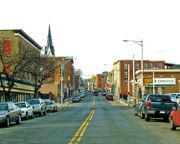
Whether they want to shop, get a haircut, learn how to dance, talk to an attorney or have their taxes done, visitors to New Britain's Broad Street neighborhood have the unusual opportunity of being able to conduct the entire day's business completely in Polish. Within the span of a few blocks, the Polish District boasts its own contracted U.S. Post office, a Polish Mall, both national and regional banks, real estate agents, accountants, several travel agencies, a dance school, European day spas, hair salons, restaurants, delis, European cafes, grocery stores, jewelers, three Polish language newspapers, a tanning salon, a television station, and one of a distinctively small number of law firms that offers legal consultations entirely in Polish. In 2006, the Hartford based litigation firm Podorowsky, Thompson & Baron opened a regional office in the heart of the Polish district at the behest of local business leaders. Founded in 1940, the firm's legal staff includes attorney David L. Thompson, son of former Wisconsin Attorney General George Thompson (R. 1963–1965) and attorney Adrian Mark Baron, a former aide to Robert F. Kennedy Jr.
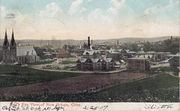
Notable visitors to the Polish district have included Rin Tin Tin, Presidents Richard Nixon and Ronald Reagan, and Pope John Paul II. In 1969, as then-Cardinal Karol Wojtyla, the future Pope gave mass at Sacred Heart Church. A statue was erected in his honor in 2007. The Polish community also produces its own newspapers. Most popular are Przeglad Polonijny, Polski Express and Polish Catholic Newspaper. New Britain has also been a tour stop for many internationally acclaimed Polish recording artists including Doda, Natalia Kukulska, Ich Troje, and Budka Suflera.
In 2006, Hollywood came calling when Broad Street's Nozewski's Meat Market and Staropolska Restaurant were profiled by the Discovery Channel's Taste of America program. "Little Poland" is also a mandatory whistle stop on the campaign trails of various politicians. During the heated 2006 election season, congressional hopefuls Nancy Johnson and Christopher Murphy were seen seeking votes among the Polish cafes and restaurants of Broad Street.
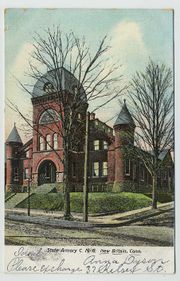
Every year on All Souls’ Day, the Polish community honors the memory of the dead by decorating the graves at Sacred Heart Cemetery. That same day, an open-air Mass is held at the cemetery. The city is also home to the only order of Polish nuns in New England as well as the only Polish-only orphanage, formerly Rose Hill Orphanage.
In the summertime, Poles and non-Poles alike flock to "Polanka" field (in back of Pulaski Middle School) to enjoy weekly Sunday picnics featuring live Polish music. At the annual Dożynki harvest festival, visitors can find buttermilk, yellow and brown amber jewelry from the Baltic Sea, traditional hand carved Polish boxes and traditional foods such as smoked kielbasa, pierogi and gołąbki. Polanka also serves as home for the Polish Falcon Club's venerable Polonia Soccer Team, which competes on the park's regulation-size soccer field. In 2007, the Club celebrated its centennial anniversary. Along with the Haller Post, (named after noted Polish General Jozef Haller) the Polish Falcons Club, serve as a second home to many of New Britain's settled families as a social venue.
The Polish community is known for fruitious gardens, immaculate flowers, and (most likely) a Catholic figure in the front yard. Many New Britain Poles cherish Our Lady of Częstochowa and preserve their Central European heritage with pride. The Polish Falcons of America offer an annual bus trip to Doylestown, Pennsylvania each September, where the American Our Lady of Czestochowa Shrine is located. Peering into backyards, visitors may observe wood burning stoves where residents smoke kielbasa.

Education and culture remain an important aspect to the lives of local New Britain Poles. Broad Street's Sacred Heart Church boasts an award winning K-8 private school and New Britain High School offers the Polish language as an elective. Local residents often attend free Polish monthly legal seminars at the law offices of Podorowsky, Thompson & Baron. Affectionately referred to as Herbata u Adwokata (Tea with the Attorney) the seminars have proven to be a great learning resource for immigrants unsure of their legal rights. Residents can also take courses in the English language through a progam offered through the Polish American Foundation. College bound students can find an extensive offering of Polish studies at Central Connecticut State University. It bears noting that Central's Science Hall is named after the Polish born Copernicus. For those with artistic wants, the Polish American Foundation sponsors orchestral works of Chopin and recurring art exhibits at the Sloper Wesoly House.
The Polish influence could be in part responsible for some vowel qualities of the so-called New Britain accent, such as nasalization of reduced vowels before /n/, though a more characteristic feature of the central Connecticut dialect is distinguished by systematic substitution of the glottal stop in place of [t] for an unreleased /t/ word-finally and before syllabic consonants (e.g. "eight" is pronounced [ɛɪʔ] instead of [eɪt]). Thus the shibboleth pronunciation of New Britain, [nuˈbɹɪʔɨː̃n] instead of [nuˈbɹɪtn̩].[7]
On September 23, 2008, through the urging of the Polonia Business Association, the New Britain City Council unanimously passed a resolution officially designating New Britain's Broad Street area as "Little Poland." In 2008, citing the city's efforts to end blight, encourage economic redevelopment and support local business investment, New Britain was designated as "Connecticut's Most Business Friendly City" by the Polonia Business Association.
Sites of interest
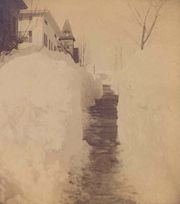
- Central Connecticut State University
- New Britain Little League
- New Britain Museum of American Art — the oldest art museum in the United States devoted to American Art. It contains a famous and comprehensive art collection from the 18th century to the present.
- Mountain Laurel Sudbury School - an independent alternative school
- New Britain Industrial Museum
- The Hospital of Central Connecticut is the city's largest employer.
- Walnut Hill Park
- Walnut Hill Rose Garden, the recently restored landmark with over 800 roses
- Hole in the Wall Theatre
- New Britain Youth Museum has children's artifacts and exhibits on regional culture.
- Capitol Lunch—a hot dog institution in New England. The "Cappie Dog" is well known to New Britain visitors for its unique and secret chili sauce.
- Stag Arms, a firearms manufacturer is located in New Britain.
- The Polish District or "Little Poland": Located primarily in the vicinity of Broad Street, visitors can find unique amber jewelry, handcrafted items, blown glass, Christmas ornaments carved chess sets, as well as eat their fill of Polish food.
Sports
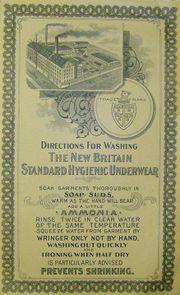
- New Britain Rock Cats, minor league professional baseball team playing in New Britain Stadium.
New Britain is also home to New Britain Little League (NBLL, previously known as Walicki - A.W. Stanley Little League), a youth baseball and softball organization that serves the children of New Britain who are between the ages of 4 and 16. New Britain Little League has been in existence for over 50 years and operates year round- offering winter clinics, a spring season, a summer tourney season, and a developmental fall ball program. NBLL plays at A.W. Stanley Park and Stanley Quarter Park, and serves over 700 children annually.
Education
Colleges and universities
The city is home to Central Connecticut State University and Charter Oak State College.
Primary and secondary schools
New Britain Public Schools operates public schools. The local high school is New Britain High School. New Britain is also home to the Mountain Laurel Sudbury School.
Transportation
Connecticut Route 9 is the city's main expressway connecting traffic between Hartford (via I-84 and I-91) and Old Saybrook and Middletown. I-84 itself clips the northwestern corner of the city. Public transportation is provided by Connecticut Transit.
New Britain may also serve as the terminus of the proposed Hartford–New Britain busway.
A nine mile long dedicated BRT system with 11 stations starting from downtown New Britain has been proposed, terminating at Union Station in Hartford. This would be constructed along an existing/abandoned Right of Way which links the two cities.
New Britain is the largest city in Connecticut without passenger rail service or an active train station. (Nearby Bristol is the second-largest.)
There are conceptual plans for extending the Metro-North Waterbury Branch, which originates in Bridgeport, through Bristol and New Britain to Berlin and then on to Hartford.
Notable residents
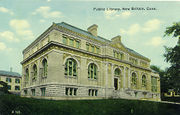
- Willie Hall—Pulaski High School, USC, Oakland Raiders Linebacker for the Super Bowl XI Champion Raiders[8]
- Velvet Sky, professional wrestler with Total Nonstop Action Wrestling.
- April Forrest born and raised in New Britain,Ct. April is signed to Universal Motown records division of UMRG.
- John T. Downey, CIA agent who was held captive in China for twenty years.
Sister cities

New Britain has five sister cities, as designated by Sister Cities International:
References
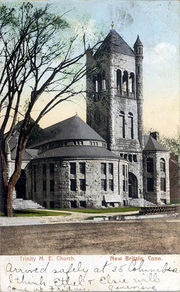
- ↑ 1.0 1.1 "Annual Estimates of the Population for All Incorporated Places in Connecticut" (CSV). 2005 Population Estimates. U.S. Census Bureau, Population Division. June 21, 2006. http://www.census.gov/popest/cities/tables/SUB-EST2005-04-09.csv. Retrieved November 17, 2006.
- ↑ "Mission". Website. New Britain-Berlin YMCA. http://www.nbymca.org/about_us/mission.php. Retrieved 2008-02-01.
- ↑ "Section VII: Local Government". Interactive Connecticut State Register & Manual. Connecticut Secretary of the State. http://www.sots.ct.gov/RegisterManual/SectionVII/SecVIITOC.htm. Retrieved 2007-03-14.
- ↑ "Table 4. Connecticut Incorporated Places with Population over 10,000, Ranked by July 1, 2002 Population: April 1, 2000 to July 1, 2002" (PDF). Population Estimates. United States Census Bureau. 2003-07-10. http://www.census.gov/popest/archives/2000s/vintage_2002/SUB-EST2002/SUB-EST2002-04-09.pdf. Retrieved 2007-03-14.
- ↑ "American FactFinder". United States Census Bureau. http://factfinder.census.gov. Retrieved 2008-01-31.
- ↑ "Registration and Party Enrollment Statistics as of October 25, 2005" (PDF). Connecticut Secretary of State. http://www.sots.ct.gov/ElectionsServices/lists/2005OctRegEnrollStats.pdf. Retrieved 2006-10-02.
- ↑ Gary Santaniello, "Accent? What Accent?", The New York Times, September 5, 2004.
- ↑ "Raiders Capture First Super Bowl with 32-14 Drubbing of Vikings". Official website of the Oakland Raiers—History—Greatest moments. The Oakland Raiders. http://www.raiders.com/history/gm1.jsp. Retrieved 2007-01-31.
- History of New Britain by Camp, (New Britain, 1889) is a valuable source of information.
- A Walk Around Walnut Hill, 1975, written by the late Kenneth Larson, an artist and historian and vocal opponent of the city's redevelopment program. This illustrated book was part of an effort to make the city aware of its rich architectural history.
- New Britain, by Alfred Andrews, 1867. The Andrews history predates Camp's work and has an especially strong focus on the city's early religious and family histories.
- A History of New Britain, by Herbert E. Fowler, 1960. This work was commissioned by the New Britain Historical Society. It's a comprehensive study. Dr. Fowler, a professor at Central Connecticut State University, died in 1963 at the age of 80.
- The Story of New Britain, by Lillian Hart Tryon, 1925, and published by the Esther Stanley Chapter of the Daughters of the American Revolution. It includes richly detailed sketches by Mortimer Warren of old New Britain scenes.
- Images of America, New Britain, by Arlene Palmer, 1995. A former curator of the New Britain Public Library's Local History Room, Ms. Palmer prepared a series of books that document, in photographs, the city.
- New Britain, The City of Invention, by Patrick Thibodeau and Arlene Palmer. Thibodeau is a former reporter and editor at The Herald.
External links
- City of New Britain
- Greater New Britain Arts Alliance
- New Britain Police Department
- New Britain Downtown District
- East Side Community Action/ Neighborhood Revitalization Zone
- CT Transit Rapid Transit Planning Commsion
- The Best Of New Britain
- BBC Special on Polish Community in New Britain
|
||||||||||||||||||||
|
|||||||||||||
